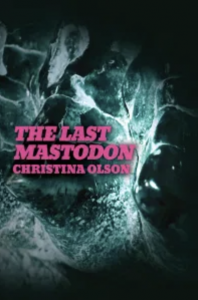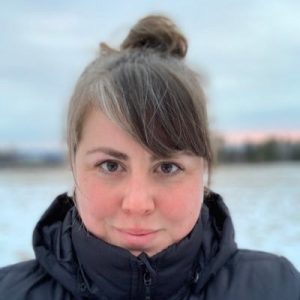by CHRIS HUEBNER

Christina Olson, The Last Mastodon (Rattle, 2019), pp. 36.
Georgia-based poet Christina Olson’s The Last Mastodon is a thought-provoking joy, due to both the thematic content and inventive structures of many of its poems. In our era overwhelmed by ecological disasters—hurricanes, floods and rampaging viruses—Mastodon is a timely meditation on the meaning of human and natural, and the personal and planetary.
My first dream career, all the way back when I was in kindergarten, was to become a paleontologist. Back then, my favorite place to go when visiting family in Los Angeles was the La Brea Tar Pits. I was unaware, until reading this chapbook, of the interesting, stuttering nature of that name. La Brea means “the tar,” so to call them “the la Brea Tar Pits” is to say “the the tar tar pits.” Additionally, my own research interests are located in the broad field of “the environmental humanities,” and I’ve spent much of the last few years reading anthropocene scholarship.” In this body of research, thinkers like Bruno Latour, Dipesh Chakrabarty and Donna Haraway work to make sense of a world threatened by anthropogenic climate change. They reevaluate the hubris of humanity and rethink the place and purpose of a natural world that can no longer be contained by humans and instead seems to have the capacity to act and react on its own.
In this context, I found many of Olson’s poems to be really fascinating. She constantly raises questions about the relation between human and mastodon, living and fossil, subject and object. In “Origin Story,” for example, Olson questions the human right to objectify Max, the titular last mastodon:
In a lake, bones slumber and we pull some to shore
A collection of human bones is a cemetery, but these we call a museum
In the next poem, “Who Gets to Be a Fossil,” this question becomes even more complicated. “Max the Mastodon gets to be a fossil / Thomas Jefferson gets to be a fossil.” But these fossils are treated differently. Jefferson with reverence while Max becomes an object of study. Jefferson “belongs to the United States of America forever” as Carol (a woman whose website Olson visits while trying to discover the location of his burial) writes on her blog. Max is instead subjected to the unforgiving realities of his environment, then the equally harsh gaze of the human scientist. He “kept wandering through the California scrub until he died & his bones turned hard & then some men in hats found them when they were digging a dam.” Jefferson, after death, retains his personhood. He remains “he.” Max, upon being disinterred by those men in hats, is “Max” no longer, instead becoming “them”—not a creature, but a collection of hardened bones.
Olson also brings our attention to Sally Hemings, who exists in the margins between historical veneration and paleontological objectification. Left out of Internet Carol’s celebration of Jefferson, Hemings and her existence are recovered by Olson. Jefferson’s fascination with the mastodon—which he believed to roam the wilds of the American West—is attached to the control he exerts over Hemings after the death of his wife, Martha. Both become objects of a white man’s dominance, both examples of “ambition and the misery it brings.”
Sally Hemings was Martha Jefferson’s half-sister. Jefferson never remarried after Martha’s death at age thirty-three.
In one version of the truth, Jefferson did not remarry because he loved Martha…
But this is also true: Jefferson did not need to remarry. He had Sally.
Lines from “Reconstruction Errors, Part 1 & 2” (“It gave my pain some geological perspective”) and “Among the Bones” (“Among the bones / In that cool room I felt / Something like the weight / of geology…”) stand out for their distention of the human perspective, the nihilistic overwhelming that often results from an encounter with a thing that lived and died eons before our species even existed, never mind you or me or our pain.

I found this aching confusion informed the structure of various poems in interesting ways, notably “Animals Doing Things to Other Animals,” “Who Gets to Be a Fossil,” and “Among the Bones.” In each of these, and others in the collection, thoughts collide and overlap haphazardly and demonstrate the difficulty of navigating the vast and contradictory timescales of the geological, historical, and personal. Olson’s thoughts and feelings about the deep past and the immediate present stack up on top of each other:
The fields surrounding Monticello are green and brown and black. In the winter, they sometimes freeze.
At La Brea, it smells of asphalt. A thick bubble inflates, then pops.
I wish I could call my father, tell him where I stand.
This passage, from “Animals Doing Things to Other Animals” is part of a poem that discusses slavery, Thomas Jefferson’s stutter, the excavation from tar pits, as well as Olson’s own perspectives and her relationship with her father. It creates an effect akin to what Dipesh Chakrabarty would call the collapse of the barrier between natural and human histories. A melancholy felt in the present pulls all these thoughts into each other and mixes them together.
But this collapse does not end in paralysis. I was impressed by the recovery project, and the optimism it implies, of the poem “Reconstruction Errors, Part 1 & 2.” It is an example of a poetic form Olson invented and called the mastodon. The form is split into two parts. The first, an eleven to thirteen line sequence. The second part is the Reconstruction, essentially a found poem made from the first part. It mimics the process nineteenth-century paleontologists went through while constructing and revising skeletons out of found fossils. As Olson writes in a blog on Superstition Review, “the power of the form comes in the side-by-side comparison of the two versions. This lets the reader see what you changed or edited, and how the narrative or meaning might have shifted.”
I found this to be exactly the case with “Reconstruction Errors.” I was astounded by how different the two parts of the poem felt, almost to the point where I could not believe that they were formed from the same pool of words. Though both parts deal with failure and loss, and though the poem’s final line is “All day I’ve tried and failed,” I was drawn to the potential for novelty that the mastodon form has. The care and attention Olson shows for the words in the first part of “Reconstruction Errors” give her the chance to find a new perspective in the second. That change is noticeable and, in our era of climate catastrophe—in which so much thinking becomes statically despondent—incredibly helpful.
This striving for possibility and hope comes through in the collection’s final poem, “A Story About Bones.” In this, Olson finds parallels between the work of poetry and paleontology:
Both the excavating of a shard
here & there, an attempt to see what fits
the painstaking assembly of meaning from fragments
I was struck by the ampersands here, and elsewhere in the collection. They seemed to serve as more than a mere replacement for “and,” instead a symbolic reminder of the confusion of the conjunction. The ampersand mark that there is not, perhaps cannot be, a clean break between two concepts, but is instead a collision, a location where two disparates twist together and intermix, an opportunity to (as Olson writes) “come back / in the new light” and discover what might not have otherwise been seen. And with this discovery, there is a chance for solace, a chance to find something that, as Olson describes in the final lines, “fits in my hand / like it’s always been there.”

